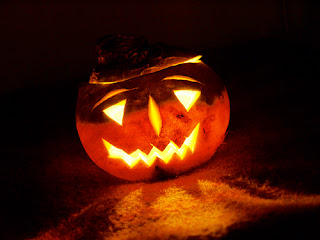 Did anyone make a Turnip Lantern for Halloween? Nowadays Pumpkin Lanterns are more fashionable, but children used to make turnip lanterns. Turnips are notoriously hard to work with. Cutting the top off the turnip would usually be done by father or mother, and many a blister was gained whilst trying to scoop out the flesh of the turnip with an old spoon and a knife. Care had to be take when cutting the eyes nose and mouth in case fingers were cut instead. Next attaching the top to the bottom with string would test your knowledge of knots.
Did anyone make a Turnip Lantern for Halloween? Nowadays Pumpkin Lanterns are more fashionable, but children used to make turnip lanterns. Turnips are notoriously hard to work with. Cutting the top off the turnip would usually be done by father or mother, and many a blister was gained whilst trying to scoop out the flesh of the turnip with an old spoon and a knife. Care had to be take when cutting the eyes nose and mouth in case fingers were cut instead. Next attaching the top to the bottom with string would test your knowledge of knots.
Lastly, was the task of finding a candle, of just the right size, to put in the bottom to give the light. Then the joy of having your lantern glow in the darkness of a Halloween night, with the evil looking face you had carved, peering at you like some terrible ghoul. Off you would go out guising, dressed in a sheet, or something equally fearsome, to pester the locals for treats in exchange for a song, dance, poem or joke, accompanied by the unforgettable odour of burning turnip.
Turnips are known by a number of names.. here in Scotland....neeps, tumshies and more widely, swedes, rutabagas, brassica.
They are extremely hardy root vegetables able to withstand snow and ice, and were used to feed animals. They were also somewhat derided as a poor person's food, but they are full of nourishment none the less.
The turnip's root is high in vitamin C. The green leaves of the turnip top ("turnip greens") are a good source of vitamin A, folate, vitamin C, vitamin K and calcium. Turnip greens are high in lutein (8.5 mg / 100 g).One medium raw turnip (122 g) contains the following nutritional information according to the USDA:[2]
- Calories : 34
- Fat: 0.12
- Carbohydrates: 7.84
- Fibers: 2.2
- Protein: 1.10
- Cholesterol: 0
They are also used in soups, stews, casseroles and can be mashed with potatoes or on their own. If anyone has a good turnip recipe we would love to put it on our Blog!
How many of you are aware that there is a major connection between the turnip and Kirkmahoe?
Patrick Miller
Botanists on a visit to Sweden discovered turnips growing wild there. Patrick Miller of Dalswinton got to know about this and in 1781 requested turnip seed be sent to him here. Having previously designed a cannon, and given designs for a steam boat to the King of Sweden, the King was happy to oblige, and sent seeds to Miller in a casket. These seeds were duly planted at Dalswinton and from the resulting crop seeds were subsequently distributed throughout Scotland and England. The majority of turnips in UK nowadays are as a result of this crop!
This also explains the name Swede being used for turnips.








No comments:
Post a Comment